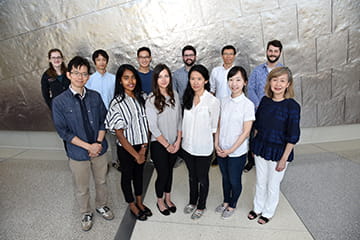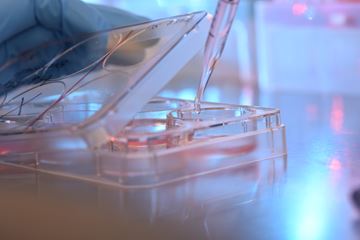With their groundbreaking discovery in 2017, researchers in the 3D Stem Cell Biology Research Group became the first lab in the world to generate inner ear tissue from human stem cells. Continuing their work in genome engineering, these medical scientists are investigating regenerative medicine for inner ear therapy and novel skin grafting application.

Regenerative Medicine for Hearing Loss
Hearing loss affects more than ten percent of US veterans. In fact, hearing loss and tinnitus are the two most prevalent disabilities treated at US Veteran Affairs hospitals across the United States, costing $2 billion annually in disability compensation. To better treat these conditions, the Department of Defense initiated its first program for funding research into hearing restoration by committing $10 million per year through several grants, including one at IU School of Medicine Department of Otolaryngology—Head and Neck Surgery.
Research teams in the 3D Stem Cell Biology Research Group investigate the restoration of hearing and promotion of hair cell regeneration by studying how specific chemical compounds can trigger hair cell regeneration after damage to these sensory receptor cells. By developing human dish-grown, three-dimensional (3D) inner ear tissues called “human inner ear organoids,” which mimic the structure and function of native human inner ear tissues, investigators are working to generate cochlear tissues containing sound-sensing receptors and neurons that transmit hearing sensation to the brain. They’re also working to produce dish-grown cochlear tissues containing dying receptors hair cells.
 These 3D organ replicas are used to test if a candidate compound with proven ability to regulate gene transcription can promote hair cell regeneration in dish-grown cochlear tissues. Human 3D cochlear organoids offer unprecedented opportunities to develop and test new hearing restoration therapies, since knowledge gained from a human model system is readily applicable to human hearing impairments. In thinking beyond the need for regenerative therapies, this model can be also used to identify drugs that protect sound-sensing receptor cells from loud noise and chemical insult. For each potential therapy, a human in vitro assay that allows for rapid screening of drug candidates could expedite discovery and pre-clinical testing.
These 3D organ replicas are used to test if a candidate compound with proven ability to regulate gene transcription can promote hair cell regeneration in dish-grown cochlear tissues. Human 3D cochlear organoids offer unprecedented opportunities to develop and test new hearing restoration therapies, since knowledge gained from a human model system is readily applicable to human hearing impairments. In thinking beyond the need for regenerative therapies, this model can be also used to identify drugs that protect sound-sensing receptor cells from loud noise and chemical insult. For each potential therapy, a human in vitro assay that allows for rapid screening of drug candidates could expedite discovery and pre-clinical testing.
Regenerative Medicine for Skin Repair (Reconstructive Surgery)
Modern medical approaches to skin grafting typically produce skin without hair follicles, sweat glands or pigmentation cells—components necessary for skin function, thermoregulation, touch sensation and appearance. For forty years, scientists attempted to recreate skin cells that possess skin structures needed to regulate these complex functions. In discovery, the 3D Stem Cell Biology Research Group generated mouse skin containing hair follicles, pores, fat and other structures through stem cells in a culture dish. Given this success, investigators at IU School of Medicine are working with National Institutes of Health in order to advance this research toward the regeneration of complex human skin and hair.
Primary Investigators
The 3D Stem Cell Biology Research Group is comprised from the work of two distinct faculty at IU School of Medicine Department of Otolaryngology—Head and Neck Surgery.


